The Payne Group
-
Based in:
Institute for Bioscience and Biotechnology Research ( description ) - About Gregory Payne
- Group Members' Areas of Research
- Biochip Collaborative Publications »

Featured Image: Electrode-imposed signals are used to assemble proteins without the need for reactive reagents. The two-step assembly approach uses 1) cathodic signals to electrodeposit the amino-polysaccharide chitosan and 2) anodic signals to activate the chitosan film for protein assembly. Proteins are shown to assemble at individual electrode addresses, with spatial selectivity and quantitative control.
The successful integration of biological components into microfabricated devices will provide "smarter" biosensors for diagnosing disease, detecting contaminants and discovering drugs. Integrating these biological components however will require hybrid fabrication methods that can exert spatial and temporal control during assembly while accommodating the labile nature of the bio-components (i.e., the nucleic acids, proteins, or cells).
The Payne Group is biofabricating by enlisting the unique properties of biological polymers e.g. chitosan) for two-way signal communication. Specifically, chitosan responds to localized electric signals from microfabricated devices and deposited as an interface for bio-components assembly. By reacting with selective substrate, the assembled biocomponents produce electric active substitutes and report the signal back to biomicrochips. This biosensor allows fast, high throughput and low limit detection of targeting biomeleculars.

Gregory Payne

Gregory Payne (Ph.D., University of Michigan, 1984) is a professor in the Fischell Department of Bioengineering, University of Maryland.
Dr.Payne is interested in building at nano-scales using enzymes and biopolymers. He has contributed with intelligent methodology to functionize surfaces of microfabricated devices with nanosized biocomponents.
Contact Information:
- Phone: (301) 405-8389
- E-mail: gpayne@umd.edu
Related External Links:
Group Members' Areas of Research
Dr. Yi Liu
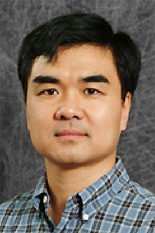
Dr. Liu' research is focused on developing fabrication strategies to assemble an interfacial platform from which biology and electronics can communicate with each other. He has demonstrated the assembly of a multifunctional biopolymer matrix by triggering its self-assembly and then enzymatically assembling biological functionality. Dr. Liu is currently exploring the concept of using a naturally derived material to capture and store biologically generated signals; the stored information can then be read through multiple sensing modalities.

Featured Image: Electrode-imposed signals are used to assemble proteins without the need for reactive reagents. The two-step assembly approach uses 1) cathodic signals to electrodeposit the amino-polysaccharide chitosan and 2) anodic signals to activate the chitosan film for protein assembly. Proteins are shown to assemble at individual electrode addresses, with spatial selectivity and quantitative control.
Dr. Liu (Ph.D., Lehigh University, 2002) is a Faculty Research Associate at the Institute for Bioscience and Biotechnology Research. He also holds a B.S. from Peking University.
Dr. Eunkyoung Kim
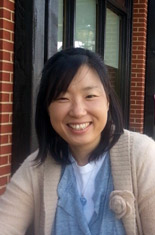
Dr. Kim has been interested in integrating the electrochemistry into the biology. Recently, she has been studying in a redox-capacitor film that can serve as a bio-electrode interface that can accept, store and donate electrons from mediators commonly used in electrochemistry and also in biology. Specially, the redox-capacitor film can perform amplification, partial rectification and switching functions. Using these properties, she could not only analyze the bacterial metabolite with a high sensitivity but also probe the redox information from biology using signal process strategies. In the future, she believes that these studies may provide some possibilities for enlisting electrochemistry and signal processing to acquire redox information from biology.
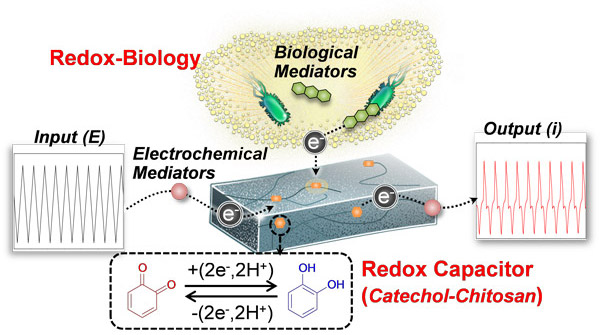
Dr. Kim (Ph.D., Electrochemistry in Korea Advanced Institute of Science and Technology, 2003) is a Faculty Research Associate at the Institute for Bioscience and Biotechnology Research.
Dr. Xianwen Hu
Dr. Hu has been interested in preparing and functionalizing biomedical materials. Currently, he is working on novel approaches for fabricating biopolymer blends that response to multiple stimuli. He also studies the ion-transfer properties in biomimetic membranes.
Dr. Hu (Ph.D., Wuhan University, 2008) is a Visiting Research Associate at the Institute for Bioscience and Biotechnology Research. He also holds a B.S. from Central China Normal University and M.S. from Huazhong Agricultural University.
Former Group Members' Areas of Research
Benjamin D. Liba
Ben is working with a novel chitosan electrodeposition mechanism that allows for anodic deposition of a covalently crosslinked chitosan hydrogel. This process allows for simultaneous conjugation of active enzymes during deposition. He is currently working to enzymatically fabricate a biofunctionalized anodic hydrogel possessing redox capabilities.
Ben is a Faculty Research Assistant at the Fischell Department of Bioengineering, University of Maryland. He graduated in 2011 from the University of Maryland with a B.S. in Cellular Biology and Molecular Genetics.
Dr. Yifeng Wang
Yifeng worked on coupling two organic thin-film assembly methods for the programmable assembly of proteins at electrode addresses within a covered microfluidic channel. He is a visiting professor from School of Material Science and Engineering, Wuhan University of Technology, Wuhan, China.
Dr. Xiaowen Shi
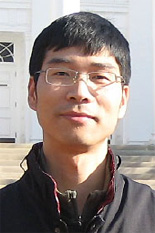
Dr. Shi is working on biomolecular assembly onto integrated biochips. He is developing new methods to connect proteins to electrodeposited chitosan (e.g., tyrosinase conjugation, metal affinity binding, biotin-avidin conjugation). Currently, he is using localized electric signals to guide protein assembly onto activated chitosan film, as shown in the scheme. This allows spatially and quantitatively control of protein assembly onto patterned biochips. In addition, he is developing methods to assemble cells onto biochips using localized electric signals.

Dr. Shi received his Ph.D. in 2006 from Wuhan University. He also holds a B.S. and M.S. from Wuhan University. Dr. Shi (Ph.D. 2006, Wuhan University) is a Faculty Research Associate at the Center for Biosystems Research, University of Maryland Biotechnology Institute. He also holds a B.S. and M.S. from Wuhan University.
Dr. Xiaohua Yang
Xiaohua worked with enzyme-mediated assembly of biomolecular components onto microfabricated electronic devices and signal recognition based on biomolecules interaction. He is developed methods to: 1) integrate biomolecules onto electrodeposited chitosan film catalyzed by enzymes such as tyrosinase and microbial transglutaminase; 2) capture and recognize signals from biomolecular interaction and 3) transform the recognition into electric or optical signal.
Dr. Mikhael Wallowitz
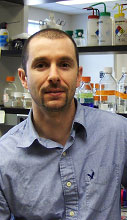
Dr. Wallowitz is working on assembling immunoassays onto pattered electrodes using biological polymers. Currently he is developing novel approaches for improving immunoassays by reducing incubation time and enhancing detection using electrochemical techniques.

Dr. Wallowitz (Ph.D., UC Davis, 2006) is a Faculty Research Associate at the Institute for Bioscience and Biotechnology Research. He also holds a B.S. from the University of Connecticut and M.S. from Texas A&M University.